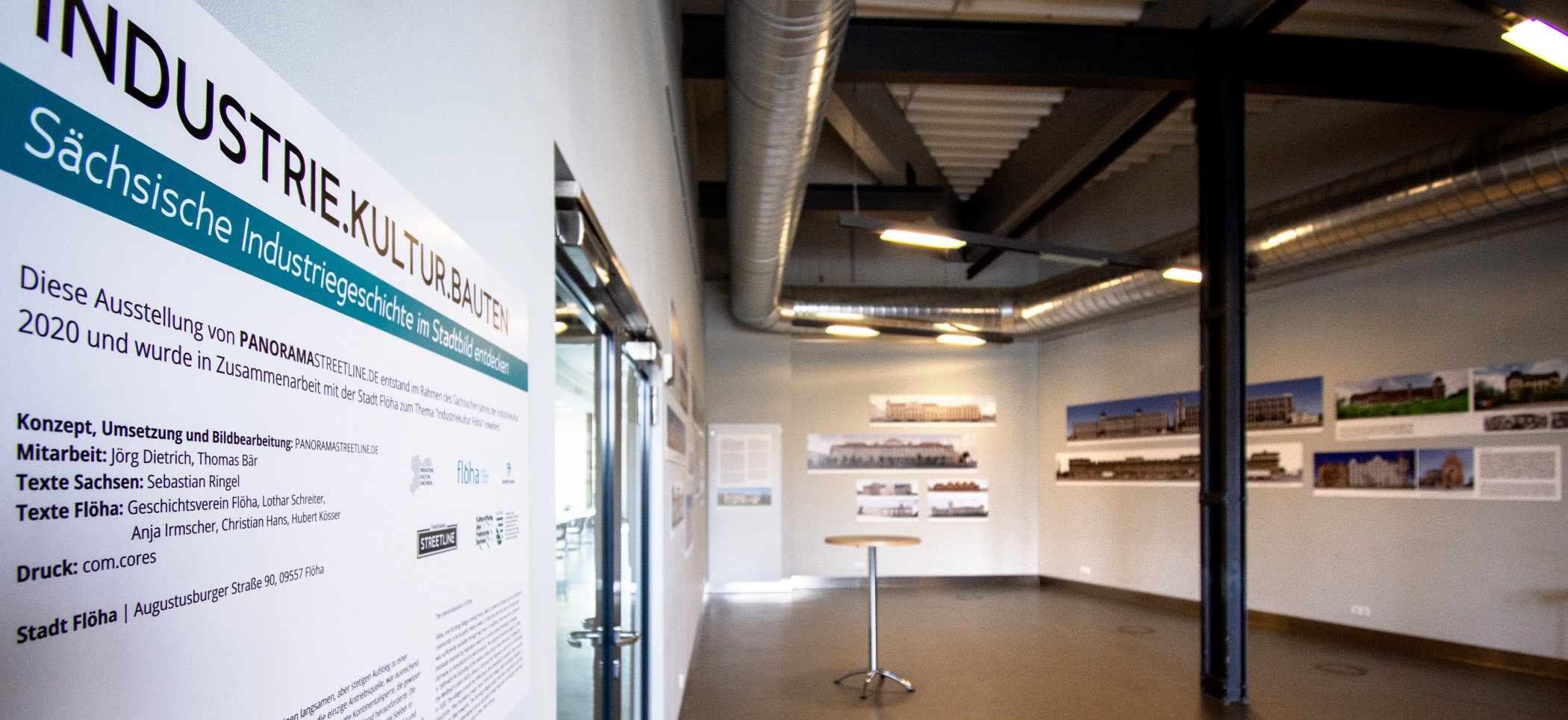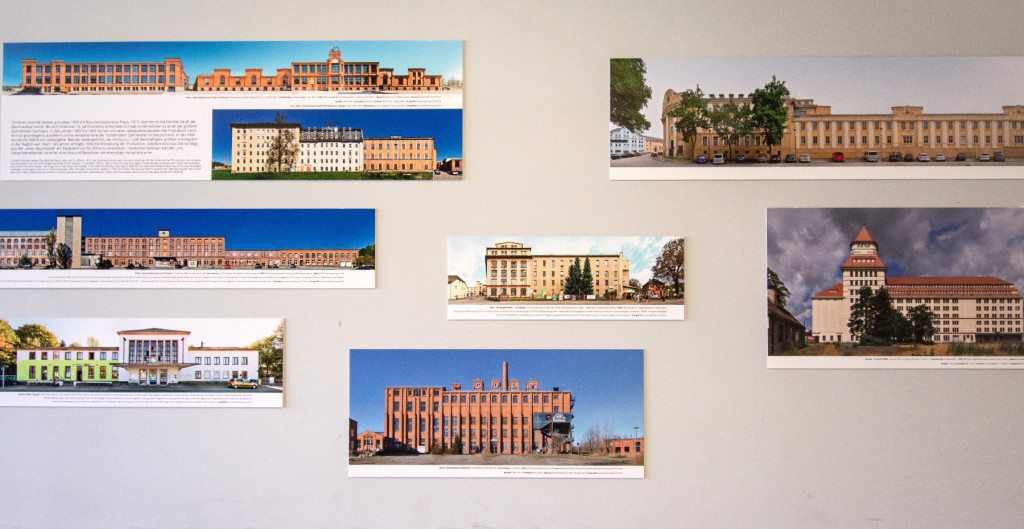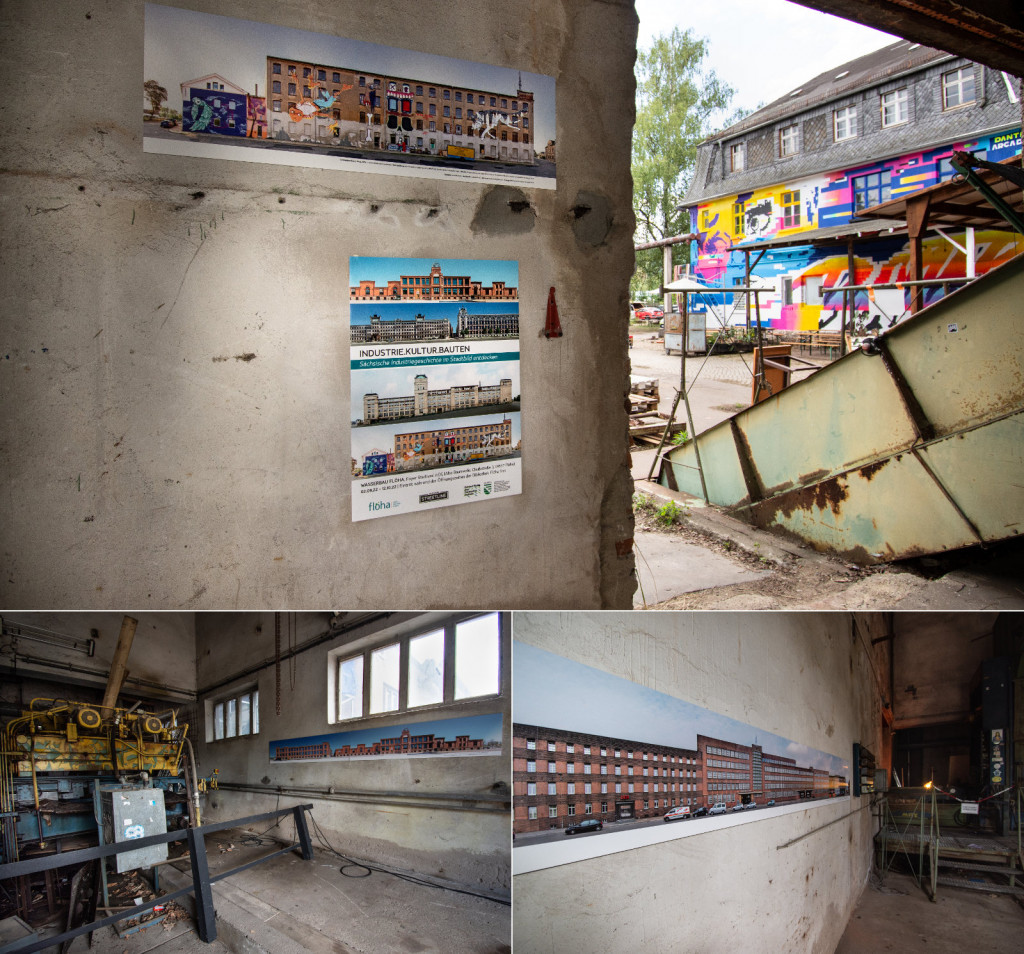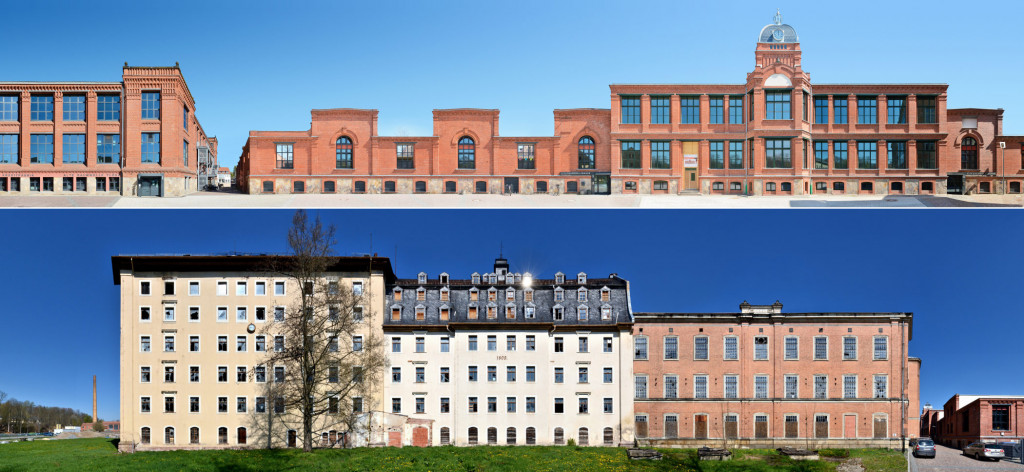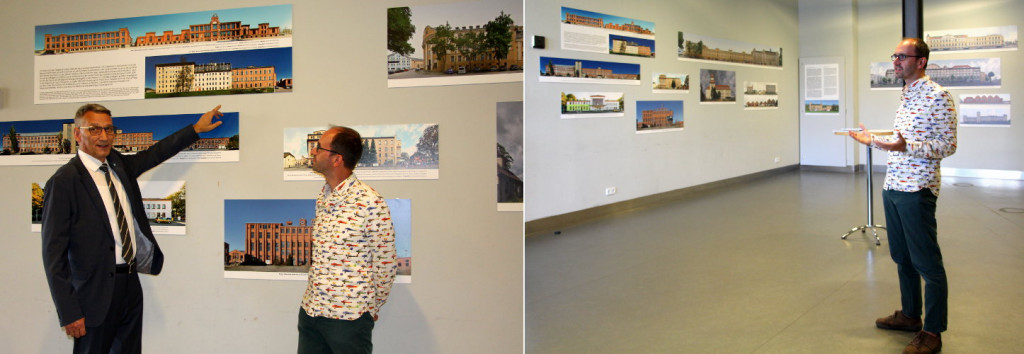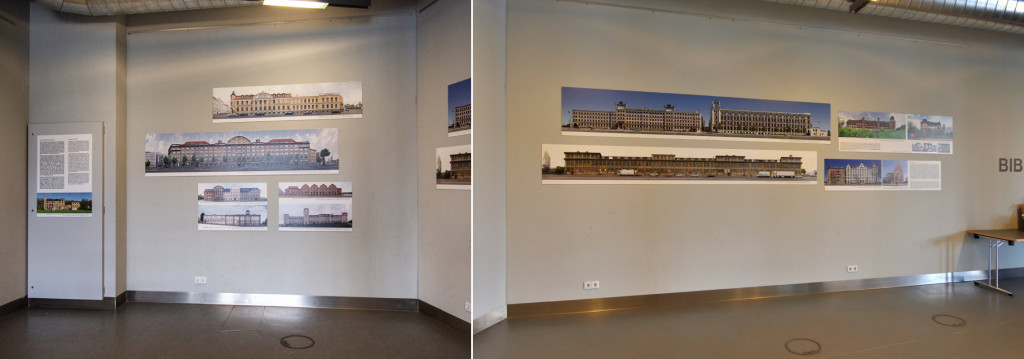Discover Saxon industrial history in its cityscape
Exhibition in the Wasserbau of the Alte Baumwolle Flöha | 02.09.22-12.10.22
Free admission during the opening hours of the library Flöha
Unsere Ausstellung “Industrie.Kultur.Bauten” entstand 2020 im Rahmen des Sächsischen Jahres der Industriekultur und wurde im Hauptbahnhof Leipzig gezeigt. In Zusammenarbeit mit der Stadt Flöha wurde sie nun um das Thema “Industriekultur Flöha” erweitert. Parallel zum, 2022 ebenfalls in Flöha stattfindenden, ibug-Festival legt unser Ausstellungsprojekt den Fokus auf das gebaute Erbe der Industrialisierung in Sachsen. Dabei steht die Industriearchitektur Flöhas im Mittelpunkt. Auf der ibug zeigt ein eigener Raum Beispiele aus der Ausstellung und verweist auf diese.
Our exhibition “Industrie.Kultur.Bauten” was created in 2020 as part of the Saxon Year of Industrial Culture and was shown at Leipzig Central Station. In cooperation with the town of Flöha, it has now been extended to include the theme “Industrial Culture Flöha”. Parallel to the ibug Festival, which also takes place in Flöha in 2022, our exhibition project focuses on the built heritage of industrialisation in Saxony. The focus is on the industrial architecture of Flöha. At the ibug, a separate room shows examples from the exhibition and invites the ibug vistors.
The industrialisation of Flöha
Flöha, one farming village among many, owes its slow but steady rise to an industrial community to its location. Water power, at that time the only source of propulsion, was sufficiently available through two rivers. In addition, there was the continental blockade imposed by Napoleon, which to a certain extent inevitably challenged Germany to manufacture its own products. The industrial revolution began in Flöha in 1809 with the founding of the Seeber cotton mill in Plaue-Bernsdorf, followed by the Weißbach cotton mill in Flöha in 1818 and the Heymann cotton mill in Gückelsberg in 1830. The villages around the Flöha basin thus developed completely new economic structures. They received a major boost from the railway, which developed rapidly in Flöha from 1866 onwards. The farming villages, which had been insignificant only half a century ago, had developed into an up-and-coming industrial community, which was to reach its first peak at the end of the 19th century.
The industrialisation of Flöha
Flöha, one farming village among many, owes its slow but steady rise to an industrial community to its location. Water power, at that time the only source of propulsion, was sufficiently available through two rivers. In addition, there was the continental blockade imposed by Napoleon, which to a certain extent inevitably challenged Germany to manufacture its own products. The industrial revolution began in Flöha in 1809 with the founding of the Seeber cotton mill in Plaue-Bernsdorf, followed by the Weißbach cotton mill in Flöha in 1818 and the Heymann cotton mill in Gückelsberg in 1830. The villages around the Flöha basin thus developed completely new economic structures. They received a major boost from the railway, which developed rapidly in Flöha from 1866 onwards. The farming villages, which had been insignificant only half a century ago, had developed into an up-and-coming industrial community, which was to reach its first peak at the end of the 19th century.
Alte Baumwolle Flöha, oben Ansicht Claußstraße mit Wasserbau, Shedhalle und Kontorhaus, unten Altbauten von 1826, 1809 und 1887
The industrial buildings portrayed from Flöha include the Old Cotton Mill, the Buntpapierfabrik, the Tulle Factory and the Flöha railway station. The Old Cotton Mill is now a special architectural and historical feature. It is located in the centre of the small town of Flöha, which was founded in the 1930s by merging several villages, directly on the river Zschopau. The vacant industrial site was gradually converted into a new town centre for the young town in the early 21st century. Flöha town hall is moving into the former Kontorhaus and a new market square is being built in the middle of the area. (see our complete panorama of the upper view)
Buntpapierfabrik Flöha zur ibug 2021
In 2021 and 2022, the ibug festival will be a guest in Flöha in Central Saxony. The site of the former coloured paper factory (Buntpapierfabrik) serves as a design venue and surprises with widely accessible halls in which coated papers lie around in rolls and stacks as if the workers had only left a fortnight ago.
The Gebrüder Wilisch Buntpapierfabrik was founded in 1878 on the site of a former spinning mill. With quality products, especially chromo papers, the company was able to develop quickly and was an important employer with about 250 employees in Plaue/Flöha until 1990 as VEB Buntpapierfabrik Flöha. Shortly after privatisation, however, the tradition-rich company went into insolvency followed by liquidation.
Mayor of Flöha Volker Holuscha and Photographer Jörg Dietrich at the exhibition opening (Fotos: Ramona Maier)
We would like to thank the town of Flöha for their support in realising the exhibition!
 |
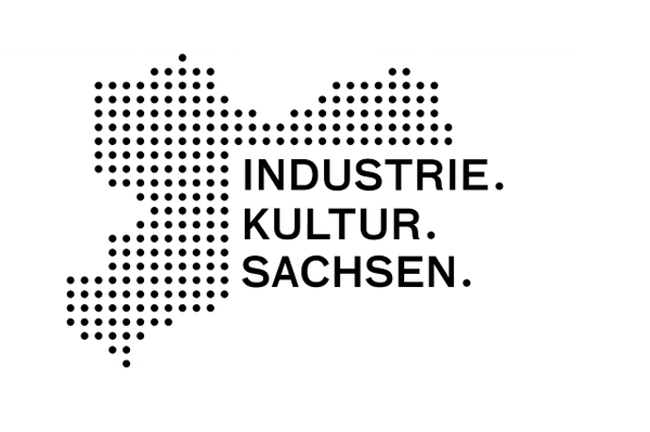 |
 |
Texts on the industrialisation of Flöha and on the individual buildings were made available to us by the Flöha Historical Society (including Lothar Schreiter, Anja Irmscher, Christian Hans, Hubert Kösser).
 Discover Saxon industrial history in its cityscape
Discover Saxon industrial history in its cityscape
Exhibition in the Wasserbau of the Alte Baumwolle Flöha | 02.09.22-12.10.22
Free admission during the opening hours of the library Flöha
Unsere Ausstellung “Industrie.Kultur.Bauten” entstand 2020 im Rahmen des Sächsischen Jahres der Industriekultur und wurde im Hauptbahnhof Leipzig gezeigt. In Zusammenarbeit mit der Stadt Flöha wurde sie nun um das Thema “Industriekultur Flöha” erweitert. Parallel zum, 2022 ebenfalls in Flöha stattfindenden, ibug-Festival legt unser Ausstellungsprojekt den Fokus auf das gebaute Erbe der Industrialisierung in Sachsen. Dabei steht die Industriearchitektur Flöhas im Mittelpunkt. Auf der ibug zeigt ein eigener Raum Beispiele aus der Ausstellung und verweist auf diese.
Our exhibition “Industrie.Kultur.Bauten” was created in 2020 as part of the Saxon Year of Industrial Culture and was shown at Leipzig Central Station. In cooperation with the town of Flöha, it has now been extended to include the theme “Industrial Culture Flöha”. Parallel to the ibug Festival, which also takes place in Flöha in 2022, our exhibition project focuses on the built heritage of industrialisation in Saxony. The focus is on the industrial architecture of Flöha. At the ibug, a separate room shows examples from the exhibition and invites the ibug vistors.
The industrialisation of Flöha
Flöha, one farming village among many, owes its slow but steady rise to an industrial community to its location. Water power, at that time the only source of propulsion, was sufficiently available through two rivers. In addition, there was the continental blockade imposed by Napoleon, which to a certain extent inevitably challenged Germany to manufacture its own products. The industrial revolution began in Flöha in 1809 with the founding of the Seeber cotton mill in Plaue-Bernsdorf, followed by the Weißbach cotton mill in Flöha in 1818 and the Heymann cotton mill in Gückelsberg in 1830. The villages around the Flöha basin thus developed completely new economic structures. They received a major boost from the railway, which developed rapidly in Flöha from 1866 onwards. The farming villages, which had been insignificant only half a century ago, had developed into an up-and-coming industrial community, which was to reach its first peak at the end of the 19th century.
The industrialisation of Flöha
Flöha, one farming village among many, owes its slow but steady rise to an industrial community to its location. Water power, at that time the only source of propulsion, was sufficiently available through two rivers. In addition, there was the continental blockade imposed by Napoleon, which to a certain extent inevitably challenged Germany to manufacture its own products. The industrial revolution began in Flöha in 1809 with the founding of the Seeber cotton mill in Plaue-Bernsdorf, followed by the Weißbach cotton mill in Flöha in 1818 and the Heymann cotton mill in Gückelsberg in 1830. The villages around the Flöha basin thus developed completely new economic structures. They received a major boost from the railway, which developed rapidly in Flöha from 1866 onwards. The farming villages, which had been insignificant only half a century ago, had developed into an up-and-coming industrial community, which was to reach its first peak at the end of the 19th century.
Alte Baumwolle Flöha, oben Ansicht Claußstraße mit Wasserbau, Shedhalle und Kontorhaus, unten Altbauten von 1826, 1809 und 1887
The industrial buildings portrayed from Flöha include the Old Cotton Mill, the Buntpapierfabrik, the Tulle Factory and the Flöha railway station. The Old Cotton Mill is now a special architectural and historical feature. It is located in the centre of the small town of Flöha, which was founded in the 1930s by merging several villages, directly on the river Zschopau. The vacant industrial site was gradually converted into a new town centre for the young town in the early 21st century. Flöha town hall is moving into the former Kontorhaus and a new market square is being built in the middle of the area. (see our complete panorama of the upper view)
Buntpapierfabrik Flöha zur ibug 2021
In 2021 and 2022, the ibug festival will be a guest in Flöha in Central Saxony. The site of the former coloured paper factory (Buntpapierfabrik) serves as a design venue and surprises with widely accessible halls in which coated papers lie around in rolls and stacks as if the workers had only left a fortnight ago.
The Gebrüder Wilisch Buntpapierfabrik was founded in 1878 on the site of a former spinning mill. With quality products, especially chromo papers, the company was able to develop quickly and was an important employer with about 250 employees in Plaue/Flöha until 1990 as VEB Buntpapierfabrik Flöha. Shortly after privatisation, however, the tradition-rich company went into insolvency followed by liquidation.
Mayor of Flöha Volker Holuscha and Photographer Jörg Dietrich at the exhibition opening (Fotos: Ramona Maier)
We would like to thank the town of Flöha for their support in realising the exhibition!
 |
 |
 |
Texts on the industrialisation of Flöha and on the individual buildings were made available to us by the Flöha Historical Society (including Lothar Schreiter, Anja Irmscher, Christian Hans, Hubert Kösser).
